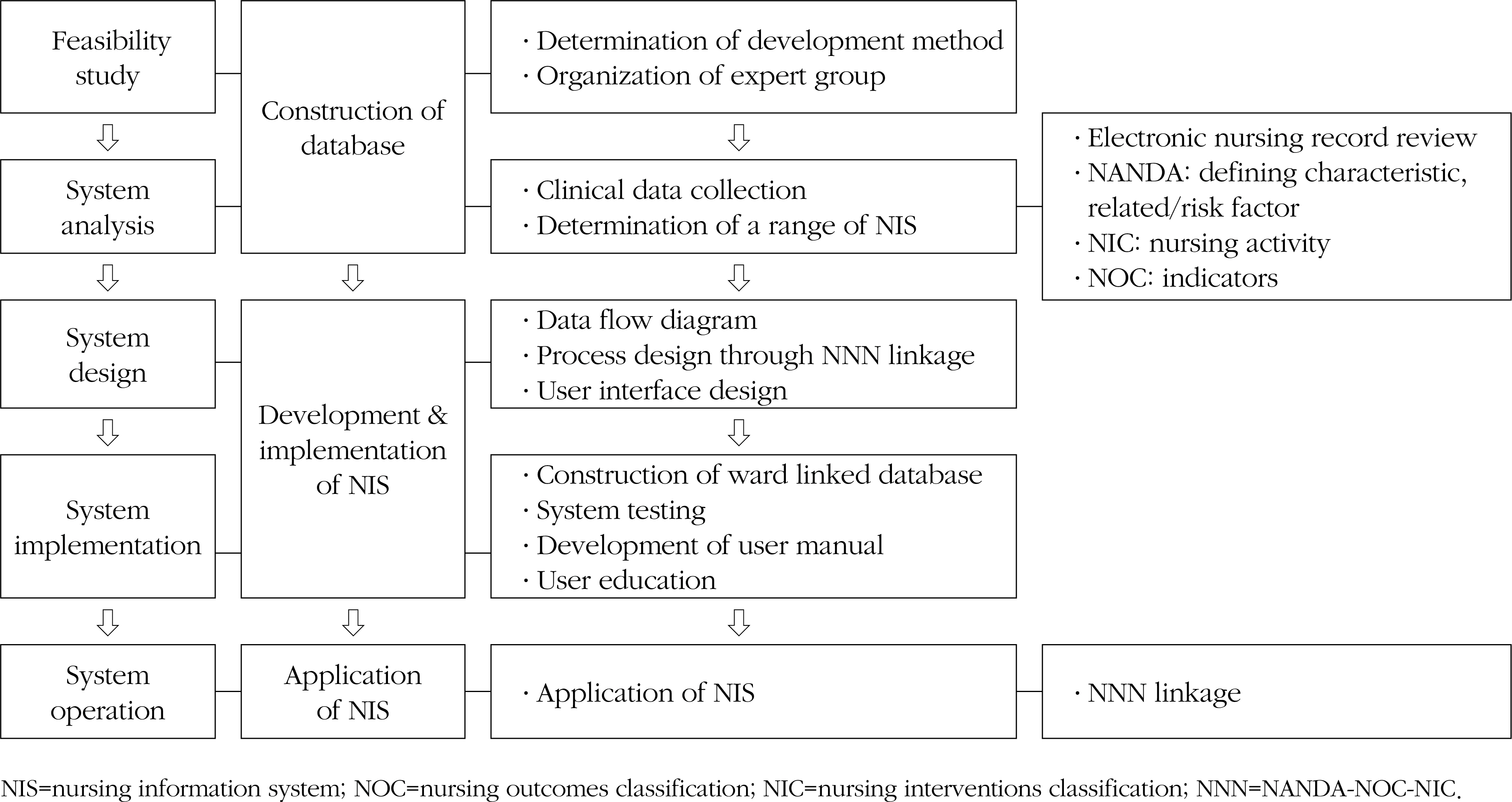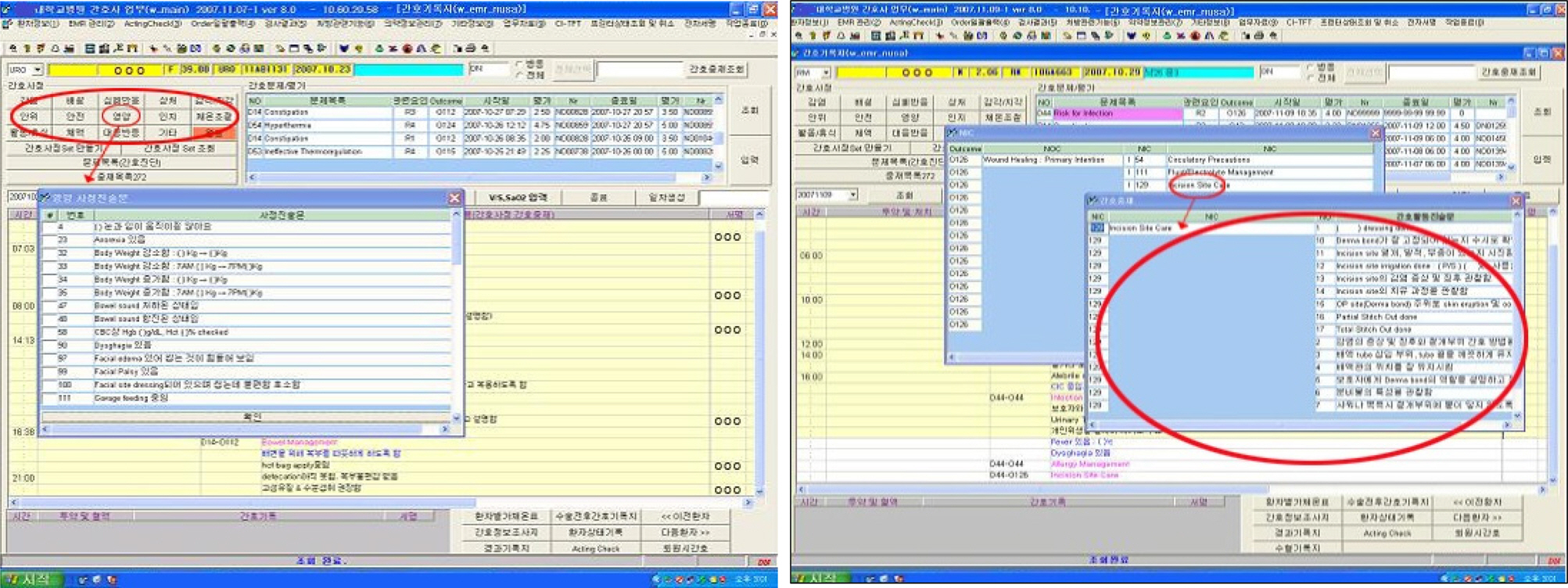1Department of Nursing, Nambu University, Gwangju
2College of Nursing, Chonnam National University · CRINS, Gwangju, Korea
© 2013 Korean Society of Adult Nursing
This is an Open Access article distributed under the terms of the Creative Commons Attribution Non-Commercial License (http://creativecommons.org/licenses/by-nc/3.0/) which permits unrestricted non-commercial use, distribution, and reproduction in any medium, provided the original work is properly cited.




Nursing Diagnoses for Database Construction (N=72)
| Domain | n | Nursing diagnosis | CVI |
|---|---|---|---|
| Comfort | 3 | Acute pain | .87 |
| Nausea | .85 | ||
| Chronic pain | .80 | ||
| Nutrition | 6 | Imbalanced nutrition: less than body requirements | .80 |
| Impaired swallowing | .77 | ||
| Deficient fluid volume | .74 | ||
| Excess fluid volume | .72 | ||
| Risk for imbalanced fluid volume | .70 | ||
| Risk for deficient fluid volume | .69 | ||
| Elimination and exchange | 10 | Constipation | .83 |
| Diarrhea | .81 | ||
| Impaired urinary elimination | .80 | ||
| Risk for constipation | .72 | ||
| Urinary retention | .71 | ||
| Impaired gas exchange | .70 | ||
| Reflex urinary incontinence | .68 | ||
| Urge urinary incontinence | .68 | ||
| Functional urinary incontinence | .67 | ||
| Bowel incontinence | .64 | ||
| Activity/rest | 13 | Impaired walking | .75 |
| Self-care deficit: bathing/hygiene, dressing/grooming, feeding, toileting | .74 | ||
| Impaired bed mobility | .73 | ||
| Impaired spontaneous ventilation | .73 | ||
| Ineffective breathing pattern | .73 | ||
| Disturbed sleep pattern | .69 | ||
| Impaired physical mobility | .68 | ||
| Impaired wheelchair mobility | .66 | ||
| Fatigue | .65 | ||
| Activity intolerance | .62 | ||
| Delayed surgical recovery | .61 | ||
| Ineffective tissue perfusion | .60 | ||
| Decreased cardiac output | .60 | ||
| Perception/cognition | 4 | Deficient knowledge (specify) | .72 |
| Acute confusion | .69 | ||
| Disturbed sensory perception (kinesthetic) | .62 | ||
| Impaired verbal communication | .62 | ||
| Coping/stress tolerance | 2 | Anxiety | .70 |
| Fear | .61 | ||
| Safety/protection | 12 | Risk for falls | .85 |
| Hyperthermia | .81 | ||
| Risk for infection | .81 | ||
| Risk for aspiration | .78 | ||
| Risk for injury | .78 | ||
| Impaired skin integrity | .73 | ||
| Ineffective thermoregulation | .73 | ||
| Risk for impaired skin integrity | .69 | ||
| Impaired tissue integrity | .68 | ||
| Ineffective airway clearance | .66 | ||
| Impaired oral mucous membrane | .66 | ||
| Noncompliance | .64 |
CVI=index of content validity.
General Characteristics of the Inpatients used in the Nursing Information System (N=130)
| Characteristics | Categories | n (%) | |
|---|---|---|---|
| Gender | Male | 69 (53.1) | |
| Female | 61 (46.9) | ||
| Age (year) | 20~29 | 15 (11.5) | |
| 30~39 | 16 (12.3) | ||
| 40~49 | 23 (17.7) | ||
| 50~59 | 26 (20.0) | ||
| 60~69 | 29 (22.3) | ||
| ≥70 | 21 (16.2) | ||
| Length of stay in hospital (week) | <1 | 50 (38.5) | |
| 1~2 | 61 (46.9) | ||
| ≥2 | 19 (14.6) | ||
| Operation | Operate | 72 (55.4) | |
| Not operate | 58 (44.6) | ||
| Admission department | Internal medical unit | Division of pulmonology | 11 (8.5) |
| Division of gastroenterology | 7 (5.4) | ||
| Division of cardiology | 7 (5.4) | ||
| Department of neurology | 7 (5.4) | ||
| Division of nephrology | 6 (4.6) | ||
| Division of infection | 6 (4.6) | ||
| Division of endocrinology | 5 (3.8) | ||
| Division of allergy | 4 (3.1) | ||
| Rehabilitation medicine | 4 (3.1) | ||
| Division of rheumatology | 2 (1.5) | ||
| Surgical unit | General surgery (ES, HPBS, GES, VTS) | 18 (13.9) | |
| Neurosurgery | 11 (8.5) | ||
| Orthopedic surgery | 9 (6.9) | ||
| Otorhinolaryngology | 8 (6.2) | ||
| Ophthalmology | 6 (4.6) | ||
| Thracic & cardiovascular surgery | 5 (3.8) | ||
| Plastic surgery | 5 (3.8) | ||
| Urology | 5 (3.8) | ||
| Gynecology | 4 (3.1) |
ES=endocrine surgery; HPBS=hepatopancreatic biliary surgery; GES=gastroenterological surgery; VTS=vascular transplantation surgery.
NANDA-NOC-NIC Linkage used in the Nursing Information System: Acute Pain
| Diagnosis | Outcome | n (%) | Intervention | n (%) |
|---|---|---|---|---|
| Acute pain | 193 (100.0) | 200 (100.0) | ||
| Pain control | 81 (42.0) | Pain management | 52 (26.0) | |
| Patient controlled analgesia assistance | 16 (8.0) | |||
| Medication management | 8 (4.0) | |||
| Teaching: prescribed medication | 5 (2.5) | |||
| Pain level | 80 (41.4) | Pain management | 31 (15.5) | |
| Heat/cold application | 21 (10.5) | |||
| Analgesic administration | 10 (5.0) | |||
| Medication administration: intramuscular | 7 (3.5) | |||
| Environmental management: comfort | 4 (2.0) | |||
| Positioning | 3 (1.5) | |||
| Anxiety reduction | 2 (1.0) | |||
| Medication administration: oral | 2 (1.0) | |||
| Medication management | 2 (1.0) | |||
| Splinting | 2 (1.0) | |||
| Medication administration: intravenous | 1 (0.5) | |||
| Medication prescribing | 1 (0.5) | |||
| Comfort level | 32 (16.6) | Pain management | 18 (9.0) | |
| Medication management | 8 (4.0) | |||
| Medication administration | 5 (2.5) | |||
| Environmental management: comfort | 1 (0.5) | |||
| Sedation management | 1 (0.5) |
CVI=index of content validity.
ES=endocrine surgery; HPBS=hepatopancreatic biliary surgery; GES=gastroenterological surgery; VTS=vascular transplantation surgery.